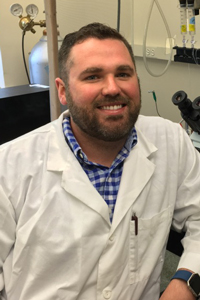
Postdoctoral Research Fellow
Training Mentor: Amy Lee, PhD
email: john-maddox@uiowa.edu
Research Project
Voltage-gated Ca2+ channel regulation through ion channel coupling
Cav1.3 L-type Ca2+ channels are expressed in sinoatrial nodal (SAN) cells where they regulate pacemaking activity. In mice, genetic ablation of these channels causes severe sinus bradycardia, and a loss-of function mutation in the CACNA1D gene encoding Cav1.3 causes a similar phenotype. In SAN cells, Cav1.3 channels are concentrated in the plasma membrane and in sarcomeric structures, which is similar to that for large conductance BK K+ channels and HCN4 hyperpolarization-activated channels. BK channels are activated by voltage and Ca2+, which in some cases originates selectively from Cav1.3. For example, spontaneous activity in adrenal chromaffin cells is diminished in Cav1.3 knock-out mice due to loss of coupling between Cav1.3 and BK. In transfected HEK293 cells, Cav1.3 and BK form a complex that enables BK channel activation within the activation range of Cav1.3. Our preliminary data also support a physical interaction between Cav1.3 and HCN channels in the brain. We and others have previously shown that the properties and cellular function of Cav1.3 can be profoundly affected by a variety of protein interactions. Based on this evidence, we hypothesize that interactions of BK and HCN4 may significantly alter the function of Cav1.3, and potentially its role in cardiac pacemaking.